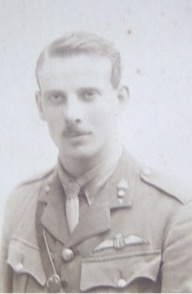Douglas Birch Richardson

| Rank: | Captain |
| Regiment: | 29th Squadron Royal Flying Corps (formerly of Royal Engineers) |
| Country: | Belgium |
| Cemetary/Memorial: | Lijssenthoek Military Cemetary, Belgium (Ref. X. A. 10) |
| Awards: | British War Medal Victory Medal |
Born on 26th June 1892 in Birkenhead, Cheshire, Captain Richardson was accidentally killed whilst flying on 29th July 1916 at Abeele Aerodrome, near Ypres. He was 24.
He was the son of Richard Richardson (1854-1895) and Florence Richardson (nee Fox, 1864-1945). Following his father’s death, his mother remarried (to Alexander Anderson, 1849-1908).
He had two sisters, Gladys Freda (1890-1967) and Florence Zoe (1894-1974) and a younger stepbrother, James Alexander Dunlop (b.1900) and stepsisters, Blanche Dunlop (1901) and Marian Dunlop (1902).
He attended Saint Ronan’s from 1905 to 1907. In 1905 he won prizes in the Juniors Long Jump and Hurdles. In 1906 he won the Senior High Jump (3ft 8in), Long Jump (13ft 7in) and 100 Yards Hurdles (20 seconds).
In 1905, The Ronian reported on his cricketing skills, “has plenty of promise for next season; has played very well of late and has a good defence”.
In May 1907 he went on to Greshams (Old School and Howson’s House). In 1908 he won a maths prize and was in the Cadet Corps shooting team. He also undertook a musketry course. In 1909 he was in the Cadet Corps shooting team and represented the school at the Norfolk Rifle Association Competition. In 1910 he was awarded Colours for shooting. He represented the school at the Schools of Empire Shooting Competition. He won the Jodrell Prize for Maths.
On leaving Greshams in July 1910, Douglas went on to Liverpool Institute for three years, where he studied engineering. He passed the first examination for the MICE before he was 21, and then went into the firm of Binnie and Deacon in London, by whom he was put on to the new water-piping at Corwen in North Wales.
In 1913, he joined the Cheshire Field Company, Royal Engineers and was in France when War was declared. In August 1914 he was awarded his second star and promoted to Second Lieutenant.
In May 1915 he suffered from pleurisy and was invalided home. It was at this time that he received a bunch of white feathers, an accusation of cowardice at the time.
At the end of 1915, he returned to visit Saint Ronan’s, giving a donation of £5 to the Chapel Fund.
He later joined the Royal Flying Corps, gaining his wings on 3rd February 1916. He returned to France in March, and was promoted to Captain and Flight Commander with the 29th Squadron on his 24th birthday.
The 29th July 1916 was an important day for the two squadrons (6th and 29th) at Abeele Aerodrome near Ypres as they were to take part with two other squadrons (16 and 20) in a large scale attack on Courtrai Station. Fourteen aircraft from Number 6 (every serviceable machine on that day) took part with escorts provided as necessary by Number 29. Captain Richardson crashed and was killed in the second of the FE8s – 6380 – whilst in the process of taking off from Abeele. Abeele was not an easy aerodrome to operate from as it was subject to heavy traffic and covered with hangars and other structures, and on this particular day, it was very hot (over 80°F) which would have had a significant impact on the lift of the aircraft.
The Ronian reported on his death:
“D.B. Richardson, who left S.Ronan’s in 1907, was staying with us only a few months ago, just after his return from France, in order to join the R.F.C. When he left S.Ronan’s, he was a Prefect and in both teams. He was sound rather than brilliant, both in work and games, but everything he did was characterised by sincerity and honesty of purpose. He was a boy with a great sense of humour, and a very affectionate, though somewhat sensitive nature. He always thoroughly enjoyed his life, and was a very excellent fellow to have in the School, and he was always grateful for anything which one could do for him. When he came to us recently, he impressed us as a very promising young officer, who combined enjoyment of his life with a real keeness for his job.”
